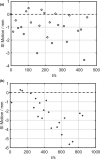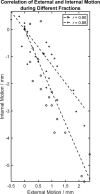Accuracy and efficiency of respiratory gating comparable to deep inspiration breath hold for pancreatic cancer treatment
- PMID: 33378792
- PMCID: PMC7856516
- DOI: 10.1002/acm2.13137
Accuracy and efficiency of respiratory gating comparable to deep inspiration breath hold for pancreatic cancer treatment
Abstract
Purpose: Deep inspiration breath hold (DIBH) and respiratory gating (RG) are widely used to reduce movement of target and healthy organs caused by breathing during irradiation. We hypothesized that accuracy and efficiency comparable to DIBH can be achieved with RG for pancreas treatment.
Methods and materials: Twenty consecutive patients with pancreatic cancer treated with DIBH (eight) or RG (twelve) volumetric modulated arc therapy during 2017-2019 were included in this study, with radiopaque markers implanted near or in the targets. Seventeen patients received 25 fractions, while the other three received 15 fractions. Only patients who could not tolerate DIBH received RG treatment. While both techniques relied on respiratory signals from external markers, internal target motions were monitored with kV X-ray imaging during treatment. A 3-mm external gating window was used for DIBH treatment; RG treatment was centered on end-expiration with a duty cycle of 40%, corresponding to an external gating window of 2-3 mm. During dose delivery, kV images were automatically taken every 20◦ or 40◦ gantry rotation, from which internal markers were identified. The marker displacement from their initial positions and the residual motion amplitudes were calculated. For the analysis of treatment efficiency, the treatment time of every session was calculated from the motion management waveform files recorded at the treatment console.
Results: Within one fraction, the displacement was 0-5 mm for DIBH and 0-6 mm for RG. The average magnitude of displacement for each patient during the entire course of treatment ranged 0-3 mm for both techniques. No statistically significant difference in displacement or residual motion was observed between the two techniques. The average treatment time was 15 min for DIBH and 17 min for RG, with no statistical significance.
Conclusions: The accuracy and efficiency were comparable between RG and DIBH treatment for pancreas irradiation. RG is a feasible alternative strategy to DIBH.
Keywords: deep inspiration breath hold; intrafraction motion; pancreatic cancer; radiation therapy; respiratory gating.
© 2020 The Authors. Journal of Applied Clinical Medical Physics published by Wiley Periodicals, Inc. on behalf of American Association of Physicists in Medicine.
Conflict of interest statement
The author have no other relevant conflict of interest to disclose.
Figures



References
-
- Brunner TB, Nestle U, Grosu AL, Partridge M. SBRT in pancreatic cancer: what is the therapeutic window? Radiother Oncol. 2015;114:109–116. - PubMed
-
- Hoyer M, Roed H, Sengelov L et al Phase‐II study on stereotactic radiotherapy of locally advanced pancreatic carcinoma. Radiother Oncol. 2005;76:48–53. - PubMed
-
- Mori S, Hara R, Yanagi T et al Four‐dimensional measurement of intrafractional respiratory motion of pancreatic tumors using a 256 multi‐slice CT scanner. Radiother Oncol. 2009;92:231–237. - PubMed
MeSH terms
Grants and funding
LinkOut - more resources
Full Text Sources
Medical

